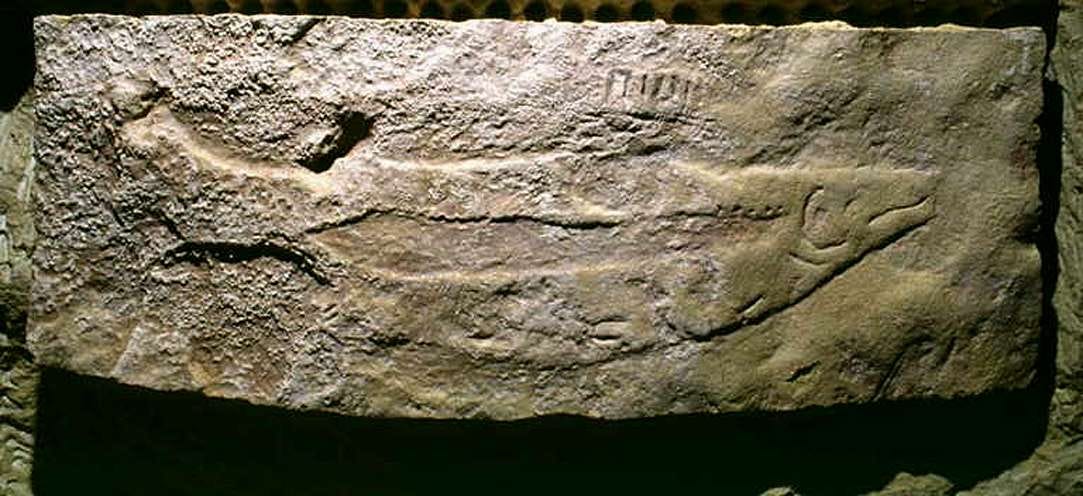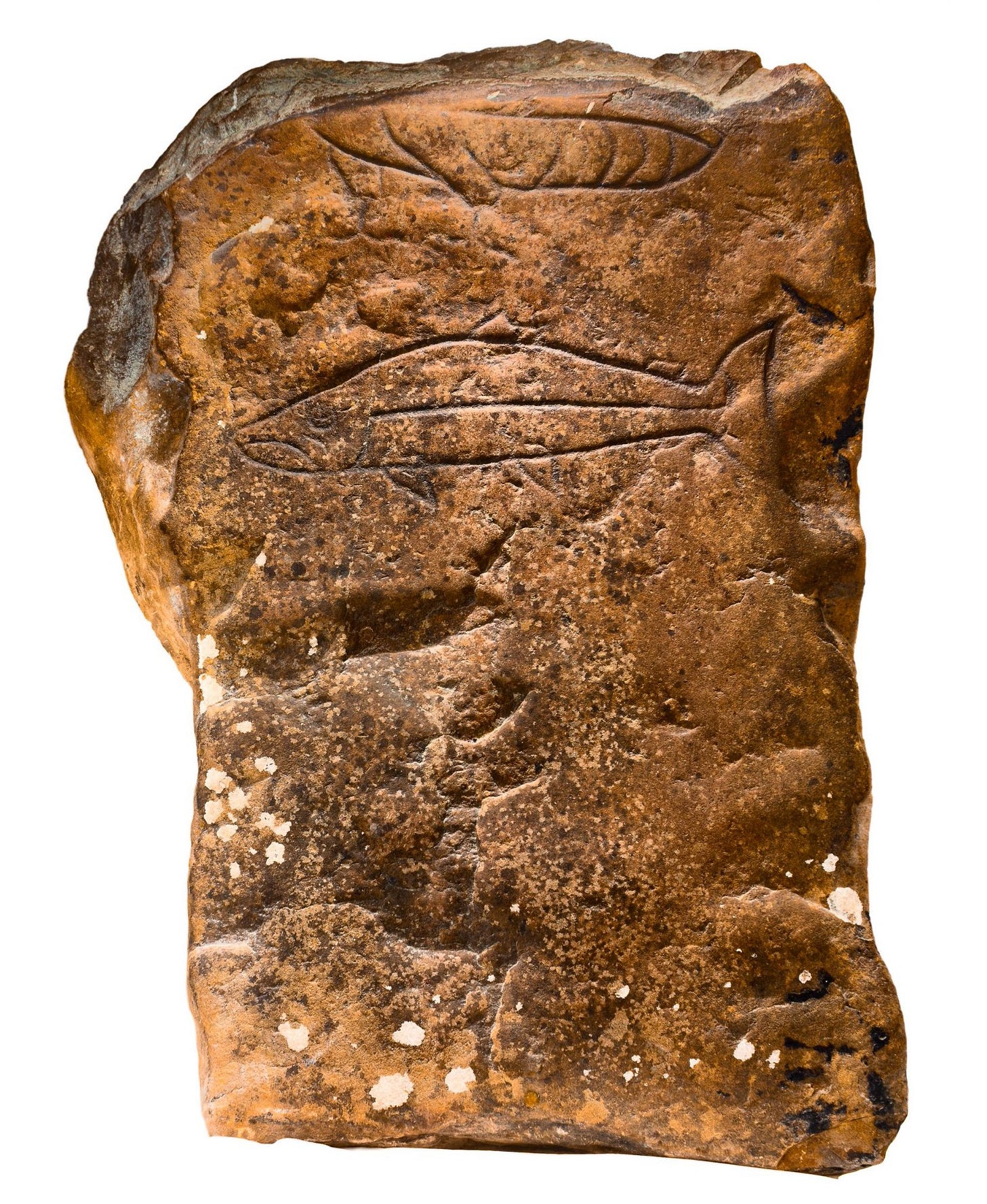Stone Age Salmon
Held by a deep curve in the river that flows out to the Atlantic from the hills in what is now south west France, there is a large rock outcrop. Cut into the lower layers of the rock, a cave. Over a period of many days, a group of European ancestors, 25,000 years ago, carved a large, life-sized salmon into the roof of this cave. During this ritual honoring they wore through multiple stone tools as they caressed the fishy form out of the ancient rock. They then ground red ochre in a stone bowl and painted the fish in the color of the spawning male salmon. This occurred deep in the last ice age.
We can only imagine why they dedicated so much effort to bringing this fish image into existence and the rituals and songs that may have gone along with the carving and painting work. It is clear that there was something very special about this fish to these ancient ancestors struggling to survive in the cold.
Our relationship with this magnificent fish is deep. This carving in France is the oldest depiction of a salmon we currently know about. This same cave also yielded an 18,000 year old reindeer antler inscribed with images of a red deer and a salmon. This is from the time the ice was beginning to recede north in Europe, revealing tundra across which the herds of reindeer could once again migrate. Along this river are still remains of 12,000 year old pools set up to catch salmon returning from the Atlantic.
The Salmon Cycle
Salmon are hatched from eggs in freshwater pools often far from the ocean. These pools provide all they need to grow to maturity, at which point, they head out, en masse, down the river into the ocean. There they roam. We know salmon can travel at least 8,000 ocean miles in four to five years before they manage to find their way back to the very river they came from and head up stream.
At this point the fish stop eating and drinking. Their stomachs shrink to create more room for eggs or spawn. They swim up river, against the current, leaping up rapids and waterfalls, some 4 meters high, until they find the very same pool into which they were born. Here, exhausted from their journey and the fasting, they seek a mate.
Making a little nest in the gravel at the bottom of the pool the female lays her eggs as the male sends his spawn towards them. Here they lay, gestating in the pool until it is time to hatch. The parents die within a few days. Their bodies becoming fertilizer for the pool and the surrounding ecosystem.
The incredible journey of the salmon has not gone unnoticed by humans, the salmon has been revered around the world. It is a living symbol of the cycle of birth-death-rebirth as it so precisely returns to it’s own source to give birth and die. It has the ability to traverse three realms - freshwater, salt water and the air as it leaps - giving the fish a mystical reputation. Its ability to find its way back home has amazed humans for thousands of years.
Salmon in Celtic Lore
Somewhere in mythic time, that time that never happened and is always happening, a salmon swims in a deep pool surrounded by nine hazelnut trees. The falling nuts nourish the salmon, feeding it wisdom, knowledge and inspiration, as it watches with one eye, the human who sits on the bank with a fishing rod. They lock eyes in that ancient dance of predator and prey, one will offer itself in a sacred death act, one will consume the flesh of the other with reverent ritual.
The Salmon is noted as the oldest animal in multiple Celtic sources. In a Medieval manuscript, preserved in Wales, is recorded one of our oldest Arthurian tales, the story of How Culwch Won Olwen. Arthur sets out to help his cousin Culwch complete a long list of impossible tasks set by Olwen’s giant father as pre-requisites for their marriage. In order to locate Mabon the lost divine child, stolen from his mother at 3 days old, Arthur sends the Interpreter of Tongues who seeks the oldest animal he can locate. This creature in turn sends the man down a line of animals until finally the Eagle tells him that Salmon is the wisest animal. The wise salmon indeed knows the location of the lost god, Mabon, and two men ride on its shoulders as a flood tide carries them upstream to the stone prison when Mabon is wailing in lament.
In one of the earliest stories of the Irish Mythological Cycle, when the Gaels arrive in ships only to be almost wiped out by a great flood within two moons of landing. Fintan is one of the few to survive, he looses his wife and their entire village. In his grief he turns into a salmon. The story tells that he travels the rivers and seas of Ireland for a full year learning the waters before morphing into an Eagle.
There are still stones standing in Scotland that depict various animals from the Pictish era (around 300 - 900 CE). One stone, now in a museum, from around 700 CE shows a salmon swimming under an eagle.
Two Celtic stories of enlightenment feature the wisdom of the Salmon. In a story of Finn MacCoull, the legendary leader of the roving band of poet-warriors, the Fianna, Finn receives the ultimate enlightenment by tasting the salmon of wisdom the old Druid Finegas pulled from the pool. (You can here my telling of this story here). In a similar story from Wales, the young boy Gwion Bach is enlightened by drops of a potion from the goddess Ceriwiden’s cauldron. He begins shifting shape as she chases him. At one point he turns into a salmon and she a hawk. In the end Ceriwiden re-births him as a human and sets him out on the river in a leather bag. He becomes caught in a salmon weir at the river’s mouth, is rescued, and goes on to becomes Wales’ most famous poet - Taliesin (You can here my telling of Taliesin’s Birth here).
Wisdom Leaping from the Otherworld
Some etymologists think that the word salmon may have come from the Latin salire, to leap. It may well have been the fish’s amazing ability to leap up rivers that attracted attention and curiosity from our ancestors. In another Irish epic cycle of myth the boy hero Cú Chulainn is known to perform many feats in battle, one the salmon-leap, which appears to allow him to launch himself in the air and descend on his enemy.
For me the salmon’s leap is a crossing from the Otherworld. Water is often associated with the subconscious, or the spirit realm, in Celtic mythology and in archetypal and depth psychology. The salmon leaping from the water into the air, from the dark into the light, from the unseen into the seen, reminds me of those moments when a knowing, an insight, an inspiration, bursts forth from who knows where into the light of consciousness.
These moments are much more common that I used to recognize. The old stories amplify and concentrate these moments into once in a lifetime, momentous, events to draw our attention to them, to underline the significance of these everyday occurrences that we so easily take for granted. The medicine for me, is not seeking that one-off, massive, explosion of enlightenment as the elixir enters my mouth, but learning to recognize, and acknowledge, the presence of the Otherworld, of the spirits, in my mundane life as subtle thoughts, knowings, intuitions, and gut-feelings. It is the salmon that knows where to find the divine child locked up in a stone prison wailing in grief. It is the salmon willing to do the work of carrying to this one those who will release him.
The salmon reminds me I can swim in the deep waters of the collective unconscious, glide through the fast rivers of my own sub-conscious and leap into the air of awareness to offer myself up as nourishment for the ecosystem, the greater field of knowledge and inspiration.






The concept of the Salmon of Wisdom offers a fascinating intersection of mythology, history, and the natural world. This figure is often portrayed as a salmon that leaps between different realms, symbolising the passage of ancient knowledge. The vivid imagery associated with this myth highlights a deeper connection to wisdom that transcends the ordinary. Additionally, it serves as a reminder of the importance of recognising subtle forms of knowledge in our daily lives, encouraging individuals to remain open to the lessons embedded in their experiences.